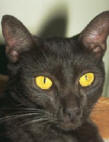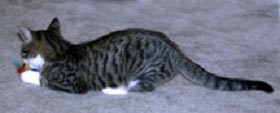What
can I do to stop my cat from
chewing?
During
exploration and play, kittens
(and some adult cats) will chew
on a variety of objects. Not
only can this lead to damage
or destruction of the owner's
possessions, but some chewing
can be dangerous to the cat.
The first step is to ensure
that the cat has appropriate
opportunities and outlets for
play, scratching, climbing,
chewing and exploration. (See
our handout on ‘Feline
play and investigative behaviors').
Next, potential  targets
of the cat's chewing should
be kept out of reach. When this
is not possible the cat may
need to be confined to a cat
proof room, or the problem areas
may have to be booby-trapped.
(See our handouts ‘Behavior
management products').
String and thread, electric
cords, plastic bags, twist ties,
and pins and needles are just
a few of the objects that cats
may chew or swallow resulting
in intestinal foreign bodies
and possibly the need for surgery. targets
of the cat's chewing should
be kept out of reach. When this
is not possible the cat may
need to be confined to a cat
proof room, or the problem areas
may have to be booby-trapped.
(See our handouts ‘Behavior
management products').
String and thread, electric
cords, plastic bags, twist ties,
and pins and needles are just
a few of the objects that cats
may chew or swallow resulting
in intestinal foreign bodies
and possibly the need for surgery.
Another
common target of feline chewing
is houseplants. The best solution
is to keep the cat away from
household plants whenever the
cat cannot be supervised. Booby
traps may also be effective.
Placing rocks or gravel in the
soil, mothballs, or a maze of
wooden skewers can help to keep
the cat from climbing on, digging
in, or eliminating in the soil.
Some cats may be interested
in chewing on dog toys or biscuits,
and feeding a dry cat food may
help satisfy some cats need
to chew. In some cats the desire
for chewing plant material can
best be satisfied by providing
some greens (e.g. lettuce, parsley)
in the food, or by planting
a small kitty herb garden for
chewing.
What
can I do for my cat that sucks
on wool and fabrics?
Sucking
on wool or other fabrics may
be seen occasionally in any
cat, but is most commonly a
problem of Burmese and Siamese
cats, or Oriental mix breeds.
Although some cats do grow out
of the problem within a few
years, the problem may remain
for life. The first step in
correction is to provide alternative
objects for chewing and sucking.
Some cats may be interested
in one of the many chew toys
or chew treats designed primarily
for dogs. A well-cooked bone
with some gristle and meat could
be considered, provided the
cat is well supervised and sucks
and gnaws on the bone without
causing it to splinter. Feeding
dry and high fiber foods or
dental foods and dental treats
may also be helpful. Making
food more difficult to obtain
by placing large rocks in the
food dish encourages the cat
to "forage". Second,
be certain that the cat has
plenty of play periods with
the owners, or even a playmate
to keep it exercised and occupied.
This may require the owner to
not only schedule play time,
but to control the cat toys
and every 1 - 3 days provide
a rotating inventory of toys
to stimulate usage. Other cats
will respond well to training
interactions with their owner,
and cats can be taught tricks.
Finally, cat proofing techniques
or booby traps will likely be
required whenever the owner
cannot supervise.
Some
cats are so persistent in their
desire to suck wool that more
drastic measures may be required.
Covering chew toys with a small
amount of a product containing
lanolin (such as hand cream)
for licking is occasionally
helpful. For some cats, it may
be necessary to leave the cat
with one or two woolen objects
to suck on, provided no significant
amounts are swallowed. It has
even been suggested that a raw
chicken wing a day might be
tried as a last resort. However,
given the prevalence of Salmonella
in uncooked chicken, microwaving
would seem prudent. If these
techniques do not help, then
it may be necessary to use a
cat cage with perches when the
cat is unsupervised to avoid
continued ingestion of material.
Some
cats have such a strong and
seemingly uncontrollable desire
to suck that the condition has
been compared to compulsive
disorders in people. The same
drugs used for human compulsive
disorders may be useful for
some of these cases. If your
cat shows persistent efforts
to suck, chew or ingest material,
a consultation with a veterinary
behaviorist, or applied animal
behaviorist may be necessary
to control the behavior.

This client
information sheet is based on
material written by Debra Horwitz,
DVM, DACVB and
Gary Landsberg, DVM, DACVB.
© Copyright 2002 Lifelearn
Inc. Used with permission under
license. March 11, 2004. |